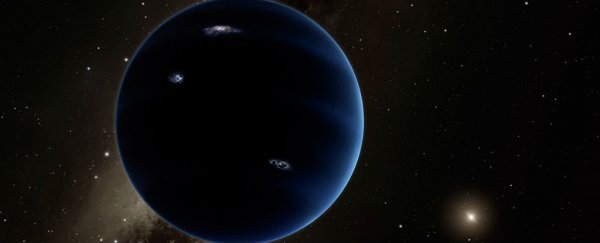The astronomer who led the charge to have Pluto demoted to dwarf planet status back in 2005 has found evidence that a huge, icy planet could be lurking on the edge of the Solar System, just past Neptune.
Nicknamed Planet Nine, it appears to be circling the Sun on a super elongated obit that takes an incredible 10,000 to 20,000 years to complete. Estimated to be about 10 times more massive than Earth and four times the size, the team says no one's noticed it until now because of how far away it is - it's about 149 billion km from the Sun, or 75 times more distant than Pluto.
No one's actually seen Planet Nine yet, so the discovery is far from confirmed, but Brown and his colleagues found evidence of its presence thanks to strange alignment of rocky objects in the Kuiper belt - Kuiper Belt Objects (KBOs) - way out on the edge of the Solar System.
"We saw a strange signal in the data that meant something odd was going on in the outer Solar System," famed Pluto killer, Mike Brown from the California Institute of Technology (Caltech), told Ian Sample at The Guardian. "All of these distant objects were lined up in a weird way and that shouldn't happen. We worked through the mundane explanations, but none of them worked out."
Back in 2014, Brown and his colleagues were investigating one of these KBOs, a dwarf planet called 2012 VP113, and discovered that for some reason, its orbit was lining up with the orbits of five other large KBOs, including Sedna. Fast forward to now, and the team has confirmed that the orbits of these six KBOs are all pointing in the same direction, and they're tilted at the same angle as all the known planets of the Solar System.
"It's almost like having six hands on a clock all moving at different rates, and when you happen to look up, they're all in exactly the same place," Brown said in statement to the press, adding that the odds of that happening randomly are about 0.007 percent. "So we thought something else must be shaping these orbits."
The two most likely explanations for what exactly that "something else" could be are undiscovered masses of debris floating through the Kuiper belt, or a hidden planet, the researchers concluded.
Brown ruled out the Kuiper belt debris hypothesis because in order for this debris to have enough force to push the six KBOs into the same orbit, the Kuiper belt would have to be 100 times more massive than it actually is.
More likely, they say, the gravitational force from a planet so distant it's been eluding us for centuries has forced the six rocky objects into line, and they figured out how this could work by complete accident.
"Their first computer models had a world circling around the Kuiper belt objects, but this did not work either," The Guardian reports. "Another explanation came by accident, when they added a massive planet on its own elongated orbit, which swung out in the opposite direction to the Kuiper belt objects - towards 3 o'clock in a Solar System viewed from above."
The team says Planet Nine should be huge enough for us to see using the world's biggest telescopes, such as the twin 10-metre telescopes at the W. M. Keck Observatory and the Subaru Telescope, both on Mauna Kea in Hawaii. But until we get actual, visible confirmation that it exists, we have to remain skeptical.
"I have seen many, many such claims in my career, and all of them have been wrong," Hal Levison, a planetary scientist at the Southwest Research Institute, who was not involved in the study, told Nature.
Chris Lintott, an astrophysicist at the University of Oxford, is a little more hopeful, telling Sample at The Guardian, "People have proposed the existence of an extra planet several times over the years, but this is the most detailed and most convincing analysis."
The results of the hunt for Planet Nine have been published in The Astrophysical Journal, and Brown says he hopes that by putting all their research out there for scrutiny, either a better explanation for the KBO alignment will be put forward, or Planet Nine will be found. "I would love to find it," he says. "But I'd also be perfectly happy if someone else found it. That is why we're publishing this paper. We hope that other people are going to get inspired and start searching."
